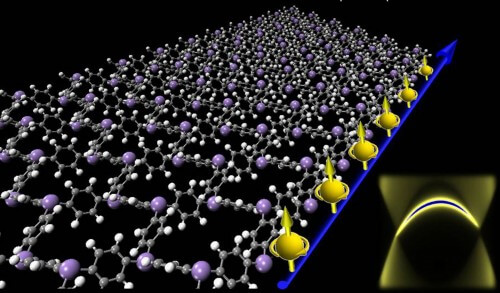Engineers at the University of Utah have shown that it is possible to make the first ever organic materials that conduct electricity along their edges, while simultaneously insulating electricity on their insides.

Engineers at the University of Utah have shown that it is possible to produce the first ever organic materials that conduct electricity along their edges, while simultaneously insulating electricity on their insides. These materials, known as "organic topological insulators", will be able to transmit information at the speed of light within quantum computers and within other electronic devices with high transfer speeds.
The study was published in the scientific journal Nature Communications and it will lead to the development of a new field of research in materials science, and will have an effect similar to how organic materials reduced the cost and facilitated the production of light-emitting diodes (LEDs) and solar cells, claims and says the lead researcher Feng Liu, who is a professor of Materials and Engineering at the University of Utah.
"This is the first demonstration ever regarding the possibility of the existence of topological insulators based on organic materials," says the lead researcher. "Our findings will expand the scope and impact these materials have in a variety of applications, from spintronics to quantum computing."
While other researchers are still required to actually synthesize the new organic topological insulators, the lead researcher explains that previous research carried out by his research team "shows that it is possible to produce an interface between two types of layers in order to create topological insulators in which electrons move along that interface."
The research team made theoretical calculations to predict the possible existence of organic topological insulators based on molecules with carbon-carbon bonds and carbon-metal bonds, compounds known as organometallic compounds. To do this, the team examined how electrons move along the edges of this type of compound, edges that look like a sheet of chicken coop fence.
In topological insulators, the particles moving in them behave as if they were massless or weightless bundles of light that conduct electricity while moving at enormous speed along the surface or edges of the material. However, when these moving particles penetrate into the material itself, their conductivity decreases to half of its original value. Moreover, these particles have a property known as spin, or angular momentum around the axis of the particle that behaves as a magnetic pole. This feature provides researchers with another way to introduce information into a particle, since this spin can be branded "up" or "down". Such a mechanism could be useful for spin-based electronic devices (spintronics components) capable of storing information both in the form of the charge type of the electrons (positive or negative) and in the form of their spin type (up or down). "We were able to demonstrate a system where the electron's spin can be manipulated so that it can transmit information," explains the lead researcher. "This feature has an advantage over normal electronic components because it is faster and there is no fear of generating heat."
At the beginning of the year, the research team also discovered a "reversible" topological insulator in a system of bismuth-based compounds in which the behavior of electrons can be controlled at the interface between two thin layers. Although inorganic topological insulators based on various materials have indeed been studied in the last decade, this has not been done for organic or molecular topological insulators.
